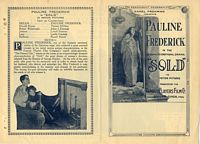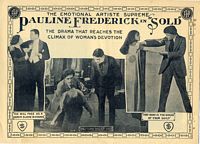

Sold (1915) Famous Players Film Co. Distributor: Paramount Pictures Corp. Presenter: Daniel Frohman. Director: Edwin S. Porter and Hugh Ford. Cast: Pauline Frederick, Thomas Holding, Julian L'Estrange, Lowell Sherman, Lucille Fursman, Russell Bassett. 5 reels. This film appears to be LOST
Click thumbnails for larger view
 |
 |
| Outside of program | Inside of program |
Nothing absorbingly interesting in this latest Famous Players feature of "Sold," with Pauline Frederick now at the Broadway. It's just a plain, mild tale without a thrill, and seems to hinge on the value of Miss Frederick as an artist's model, her value being assessed at $5,000 by herself. The film could have been called "The Secret of a Shirt Waist," for what Miss Frederick had beneath her shirt waist was what the artist paid the $5,000 for. Miss Frederick displayed a portion when posing, but whether it was $5,000 worth is a matter for artistic appraisal. Certainly there is enough acting in this picture, though. The actors are acting all over the studio, and the entire five reels were almost wholly made within the studio. The only exteriors are streets. It is a story of two painters and a girl, the girl the wife of the poorer one. With the other famous, he comes to New York, where the married artist has been obliged to bind himself to a dealer in order to raise money. He got an advance of $5,000. Using his wife as a model he did a painting everyone marveled at. The other painter, visiting the married couple, remarked he would pay any price for the services of that model, but did not then learn her identity. When things got real bad with the married couple through the dealer denuding their home of its furniture upon the artist ruining the painting of his wife that the dealer wanted, the wife (Miss Frederick) called on Richard Wainwright, the other painter, and offered herself for $5,000. He accepted. After a couple of poses the wife's husband learned of what she had done. He called at Wainwright's studio and while attempting to shoot Wainwright, shoots his wife. Then, with explanations, everything is again lovely, although the picture fails to relate why the husband as an artist should be any more successful after his wife obtained his release from the dealer with the $5,000 received than he was before binding himself. But still this is as unimportant as the picture itself. It doesn't seem as though the scenario could have exhibited sufficient strength to make the feature worth while, though there is of course, in it Pauline Frederick, without much to do excepting to manipulate a dressing gown. The busiest actor was the dealer, and second to him the husband-artist. Wainwright was played by someone who had an exact idea of what he was doing, but the others appeared to be thinking only of the camera. This halting and knowing smiles before the photography are growing very tiresome. It isn't pantomime, nor expression nor expressive. "Sold" as a Famous Players release means little, in story, playing or production.
PAULINE FREDERICK IN "SOLD"
Pauline Frederick, the famous stage favorite, who won a transcendent triumph in her initial screen characterization as Donna Roma in the Famous Players Film Company's superb production "The Eternal City," and who, as a result of her sensational success was induced by the Famous Players to devote her exclusive film services to that company, returns to the screen in a five-part adaptation of the celebrated emotional drama, "Sold."
[Omitted, photo of a man examining a woman's arm.]
Containing all the elements for vigorous emotional portrayal, "Sold," the great drama of woman's devotion, adapted from the Russian of George Erastov, provides Miss Frederick with a role as fully adapted to her finely developed dramatic talents as was that of Donna Roma in her first engagement before the camera. In "Sold," Miss Frederick portrays the sacrificing young wife of a struggling artist who refuses to commercialize his art for financial betterment. Through a series of powerful climaxes, the story reaches the point where the wife arranges to pose for her husband's successful rival in a sensational painting in order to save him from the destitution which threatens him. The husband, hearing of her act, comes to the studio of the other artist, and in a mad fury shoots at the painting of his rival, striking his wife, who is hiding behind the easel.
Miss Frederick, who proved conclusively in her portrayal of Donna Roma that she is the screen's greatest dramatic actress, will undoubtedly strengthen this position through her powerful rendition of this role. Miss Frederick's methods of interpreting tense emotion are unsurpassable. She delineates all the broken heartedness and despair of the crushed wife with appealing pantomime.
"Sold".
Pauline Frederick and Excellent Supporting Company Appear in Emotionally Forceful Famous Players Drama.
Reviewed by Lynde Denig.
Even for a Famous Players cast, and no company maintains a higher average, that selected by Edwin S. Porter and Hugh Ford for the photoplay interpretation of "Sold" is striking. In "The Eternal City" Pauline Frederick won immediate recognition as one of the most effective actresses thus far seen in pictures. She did not need the prestige of her stage reputation to make her a valuable asset to the screen. She is given apart demanding emotional sincerity, such as she found in "The Eternal City," and there are few, indeed, who can portray it with equal impressiveness. Miss Frederick photographs beautifully, and by nicely shaded acting succeeds in conveying to an audience the moods of a character as they vary through a series of dramatic episodes. She draws the Helen of George Erastov's story as a woman of real depth of feeling and self-sacrificing character.
[Omitted, photo of one man picking up an unconscious woman while another man looks on.]
For the rest, we find in this admirable cast, Thomas Holding, Julian L'Estrange, Lowell Sherman and Russell Bassett. It is a picture in which everything is presented with artistic harmony. The acting is kept consistently in the key of dignified drama, the story is carefully motivated as it works up to a climax, corresponding to the third-act climax of a stage play, and a sure sense of the fitness of things is manifest in the settings. The photoplay, presented in five reels, leaves the impression of a subject carefully prepared in each detail and directed by a man who knew precisely what effects he wished to gain.
"Sold" is based on the vicissitudes of a young artist who finds it difficult to express ideals in his paintings and at the same time find a market. Eventually he is forced to sell himself to a mercenary dealer, the terms of the contract calling for pictures adapted to popular taste. Donald makes the sacrifice that he may be enabled to provide for his wife, but there is a break with the dealer over a sketch in the nude. Helen thinks to release her husband from his obligation by posing for another artist, a former admirer, who will pay an exorbitant price for sittings. She intends to give the money to the annoying art merchant; but Donald misunderstands her motives in going to the studio of his brother artist, and preceding a satisfactory explanation there is a thoroughly dramatic conflict forcefully handled by Miss Frederick, Mr. Holding and Mr. L'Estrange.
SOLD (Famous Players--Five Parts--Aug. 5)--The story is of two artists, one a success and the other, although with far greater ability, lacks the funds with which to make the connections that contribute toward success. Both love the same woman, who selects the poor artist as her husband. Through a long period of stress and financial difficulties she emerges with the determination to aid her rich artist to their home, he admires a painting of her husband's for which she has posed in the nude. The rich artist explains that he requires just such a model for the completion of a painting upon which he has been at work, "The Harem Market," and that he would be willing to pay thousands of dollars for her services. Later, the wife, in order to obtain the money with which to assist her husband, visits the rich artist, tells him she was her husband's model, and that she will accept his offer. In time, the husband learns of her act, and entirely misunderstanding her motive, denounces her as a false wife. How his faith in his sacrificing wife is restored, and how the dawn of a new life brightens before them is tenderly unfolded in the photoplay.
Last revised, September 24, 2005